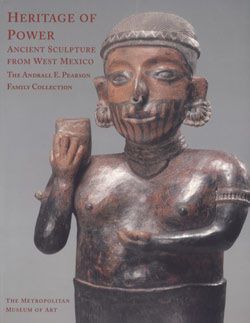Standing Figure
Not on view
The spectacular finish of this solid figure is a classic feature of the Chupícuaro style. The red slip is brilliant and multi-tonal, with white or cream slip providing contrast and detail. Overall, the surfaces of the sculpture are smooth and highly burnished. In profile, the figure appears quite flat. The top of the elongated head curves backward, its shape suggestive of cranial deformation. Instead of hair covering the head, the figure seems to be wearing a white cap with a thick strap under the chin; on the front of the cap, at the top, is a thin white stripe dividing a block of red. The facial features are modeled: large eyes, outlined in white with carved rounded pupils; a protruding nose with drilled nostrils; and a deeply gouged mouth, slightly smiling. Ears are indicated by simple, rounded indentations on the sides of the head.
The figure wears an elaborately decorated costume. A pattern of diamond shapes and cross-hatching in white on red covers most of the front of the torso. The architectural stepped-pyramid motif outlined in white on the figure’s back may be a graphic reference to a specific place. The bold designs on both front and back, as well as the white slip on the figure’s upper legs, may represent a woven garment or body paint. Most of the lustrous bichrome ceramics and figures from Chupícuaro were recovered from funerary contexts.
Further reading
Butterwick, Kristi. Heritage of Power: Ancient Sculpture From West Mexico: The Andrall E. Pearson Family Collection. New York, New Haven, London: The Metropolitan Museum of Art, 2004, no. 15, pp. 58–59.
Darras, Véronique, and Brigitte Faugère. Cronología de la cultura Chupícuaro: Estudio del sitio La Tronera, Puruagüita, Guanajuato. In El Antiguo Occidente de México: Nueva Perspectivas sobre el Pasado Prehispánico, ed. Eduardo Williams, Phil C. Weigand, Lorenza López Mestas, and David Grove. Guadalajara: INAH/Colegio de Michoacan, 2005, pp. 255-281.
Faugère, Brigitte Pretty Face and Naked Body in Context: Meanings and Uses of Chupícuaro Figurines (Guanajuato) during the Late Formative, in Anthropomorphic Imagery in the Mesoamerican Highlands: Gods, Ancestors, and Human Beings, edited by Brigitte Faugère and Christopher Beekman. Boulder: University Press of Colorado, 2020.
Halperin, Christina T., Katherine A. Faust, Rhonda Taube, and Aurore Giguet, eds. Mesoamerican Figurines: Small-Scale Indices of Large-Scale Social Phenomena. Gainesville: University Press of Florida, 2009.
Porter, Muriel N. Excavations at Chupicuaro, Guanajuato, Mexico. Transaction of the American Philosophical Society vol. 46, 1956, pp. 515–637.
This image cannot be enlarged, viewed at full screen, or downloaded.


